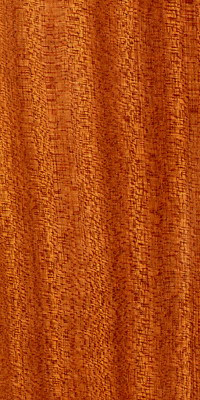

Sapelli is an exotic species native to West and Central Africa, the most abundant of the commercial meliaceae. It is a reddish brown wood, a choice material in cabinet making and fine carpentry.

Entandrophragma cylindricum
Family: MELIACEAE (angiosperme)
Commercial restrictions: no commercial restriction
The tropical tree Sapelli is a very tall tree that can reach 60 meters in height and up to 2.80 meters in diameter. The bole sometimes has bases or buttresses, and grows straight and cylindrical.
The grey-brown bark is smooth in young sapelli and becomes scaly with time. Its slice, pinky then brown when exposed to the air, gives off a cedar odour. The clear foliage is distributed in large star-shaped tufts at the ends of the branches.
Suppliers : Sapelli suppliers
Sappelli wood has a reddish-brown color. It is a choice exotic species in cabinet making, decoration, interior and exterior fine woodwork. It is also suitable for parquet flooring and panelling and for boat interiors. Its good peeling aptitude allows the manufacture of plywood.
Sapelli is a wood of mediocre natural durability, it is necessary to treat it against termites, and it is also necessary to do a preservative treatment against rot in case of risk of temporary humidification.
The species Sapelli is found over a wide distribution area from the forests of Sierra Leone in the west, to Uganda in the east, and south to the Democratic Republic of Congo.
The tree Sapelli grows at low altitude, up to 500 meters, in areas where the temperature varies between 15 and 32° C, with an annual rainfall of between 1,200 and 2,500 mm and a dry season of less than four months.
Seedlings can remain under shade for several years while waiting for enough light to grow. Young plants appreciate half shade, then full light as they grow.
Sapelli avoids swampy soils and develops preferably on dry soils of plateaus or slopes, so it is always found more than 6 km from the coast. It is a transition species between evergreen forest and semi-deciduous forest.
The tropical species sapelli is a deciduous plant: it totally loses its leaves for 15 days to 1 month, or gradually for 2 to 3 months, in October-November in the west of its distribution area, and from November to January in the east.
The seeds are dispersed by the wind. It is sometimes necessary to wait 35-45 years for the first flowering and 60-80 years for the first fruiting that the tree is tall enough and has abundant sunshine.
See the Tropix sheet of Sapelli (CIRAD).
See the Tropix sheet of Sapelli (CIRAD).
See the Tropix sheet of Sapelli (CIRAD).
See the Tropix sheet of Sapelli (CIRAD).
Sources:
Copyright photo: Q. Meunier, C. Moumbogou, J.-L. Doucet, 2015, Les arbres utiles du Gabon (bole, leaves, seedling)
use(s) for this species :